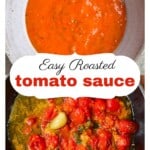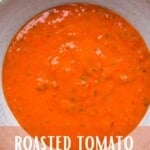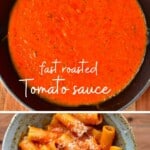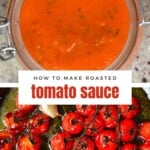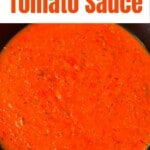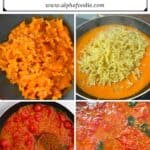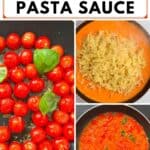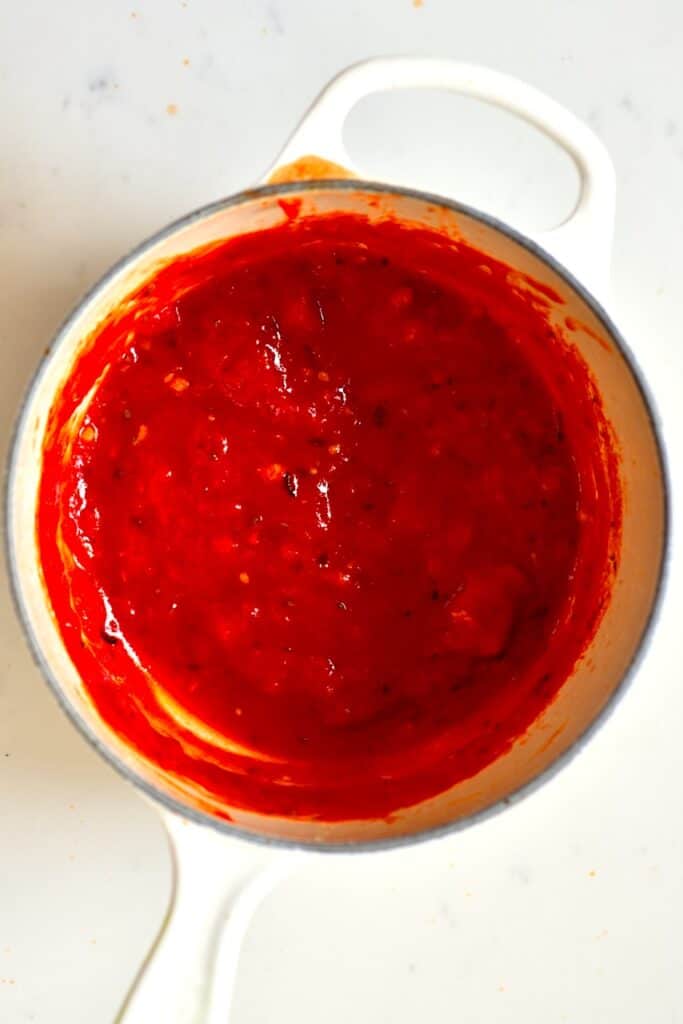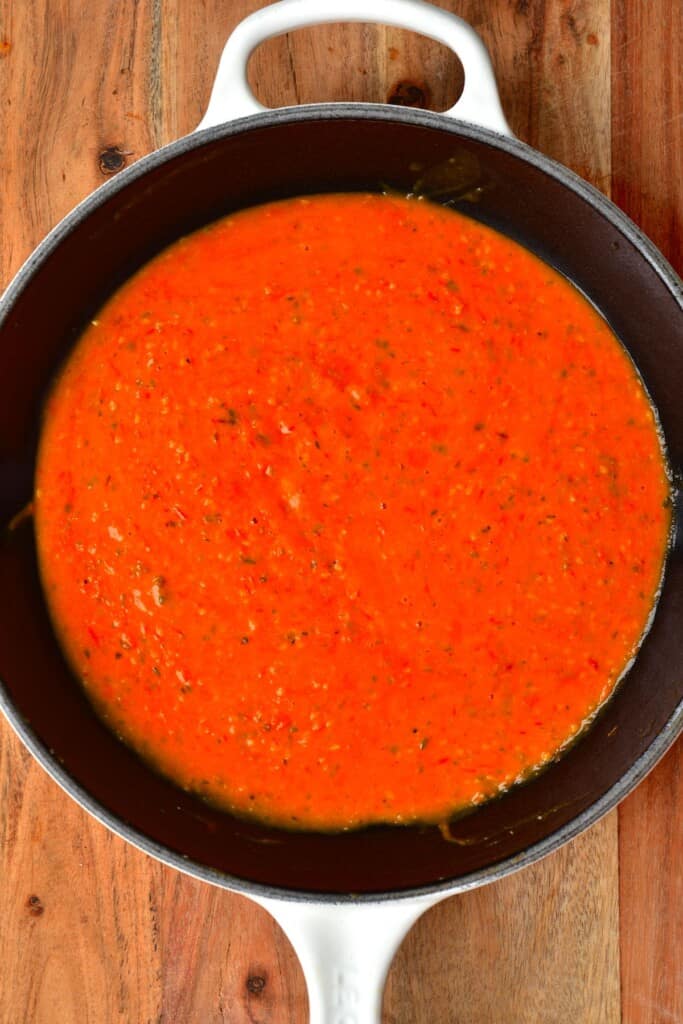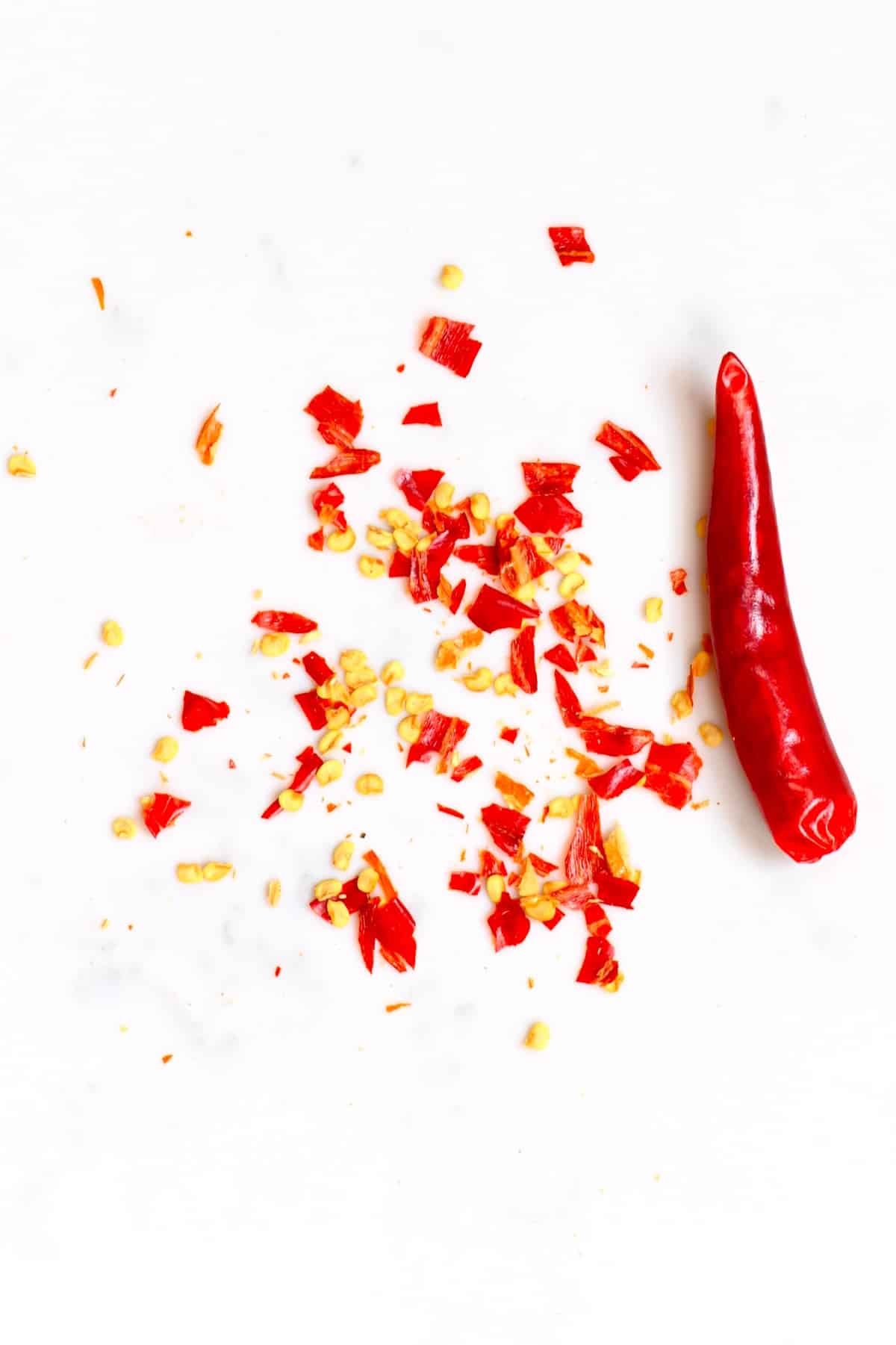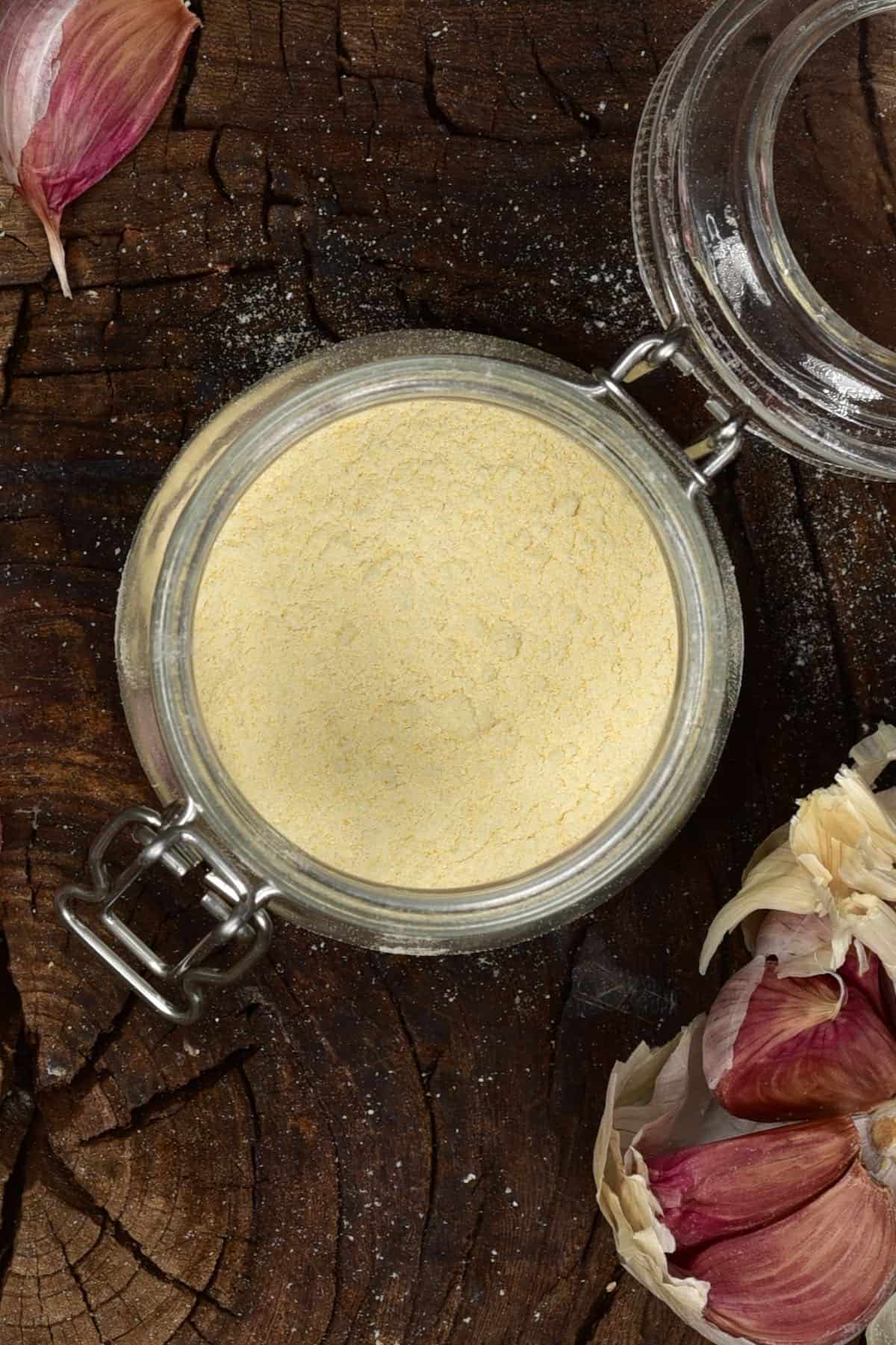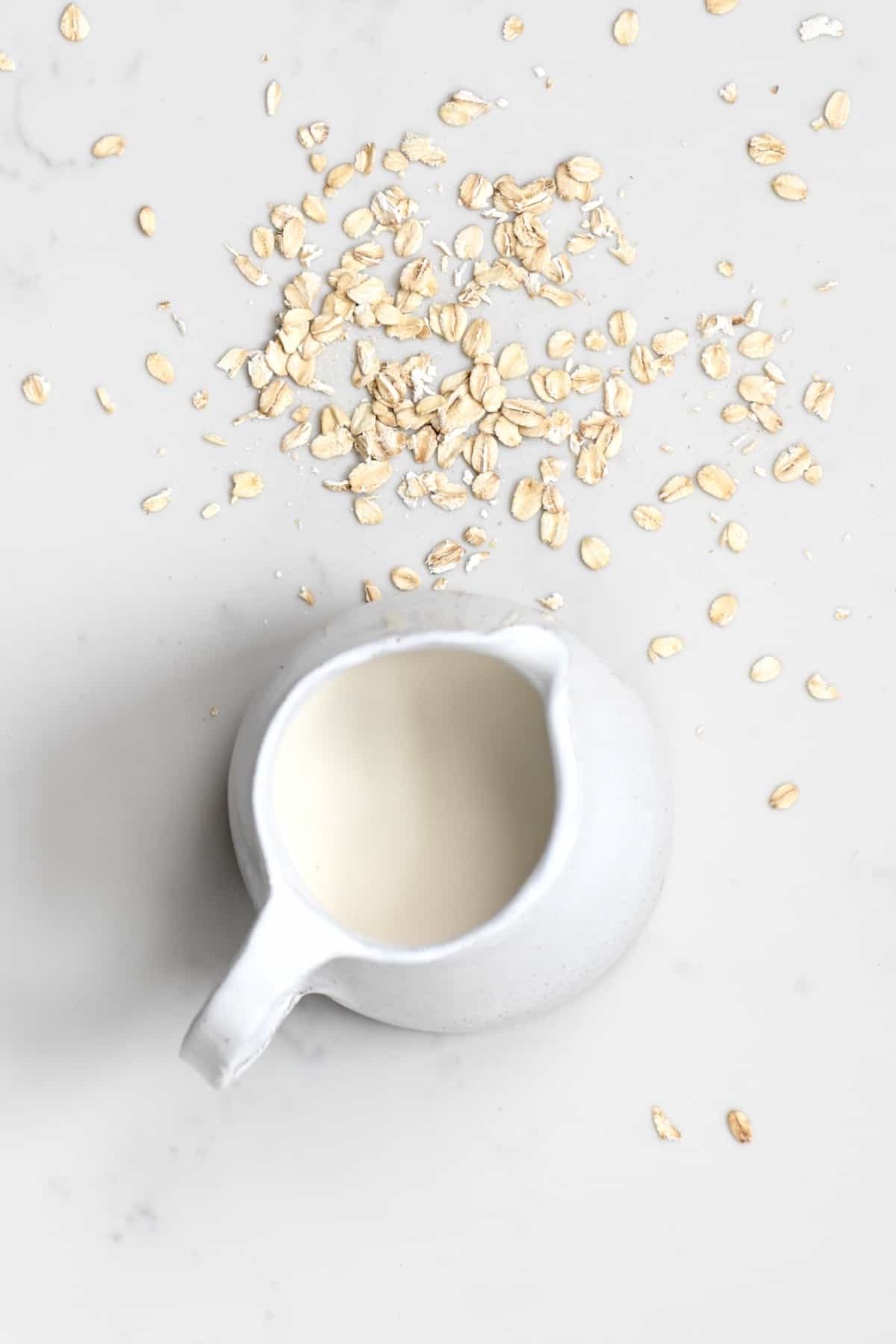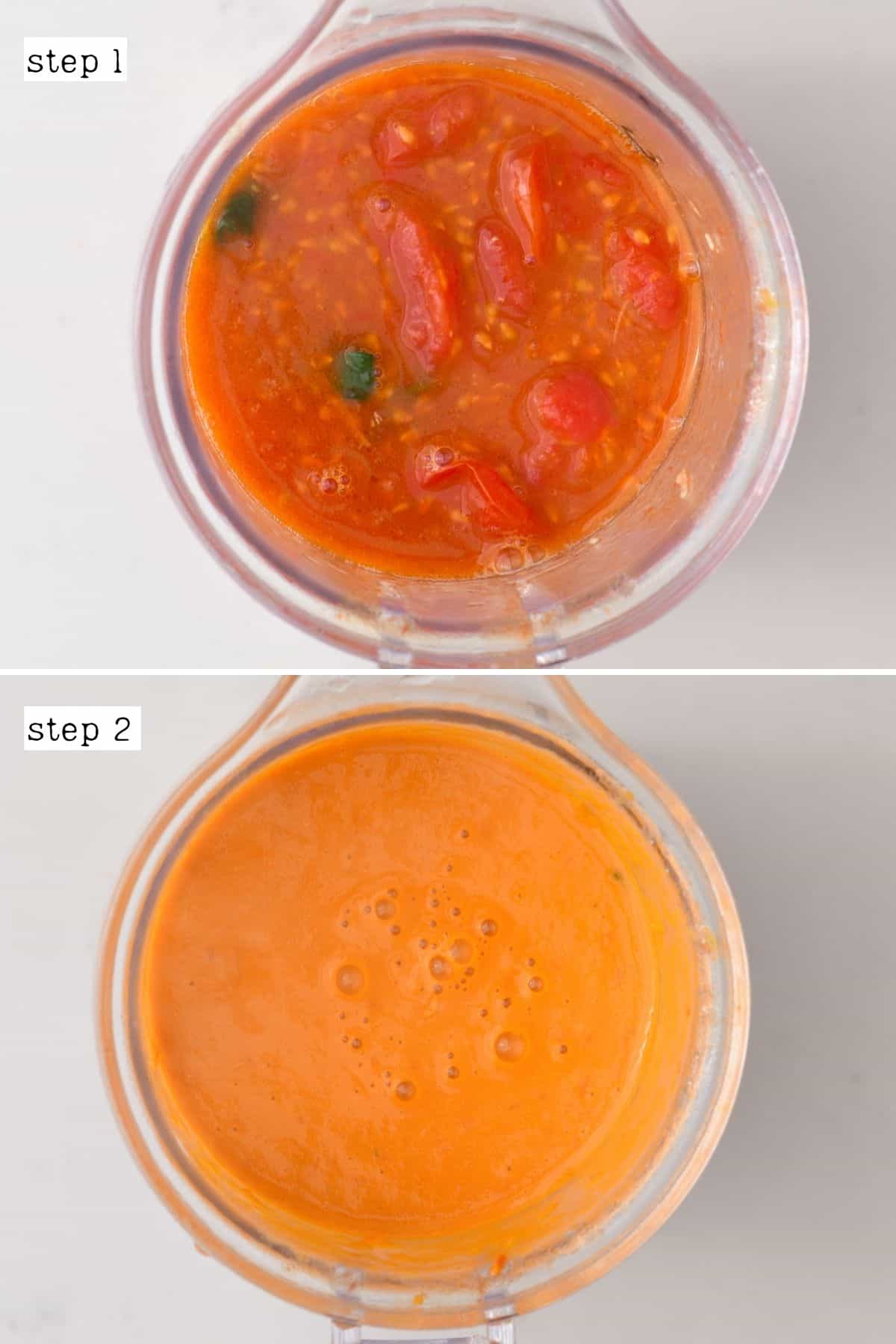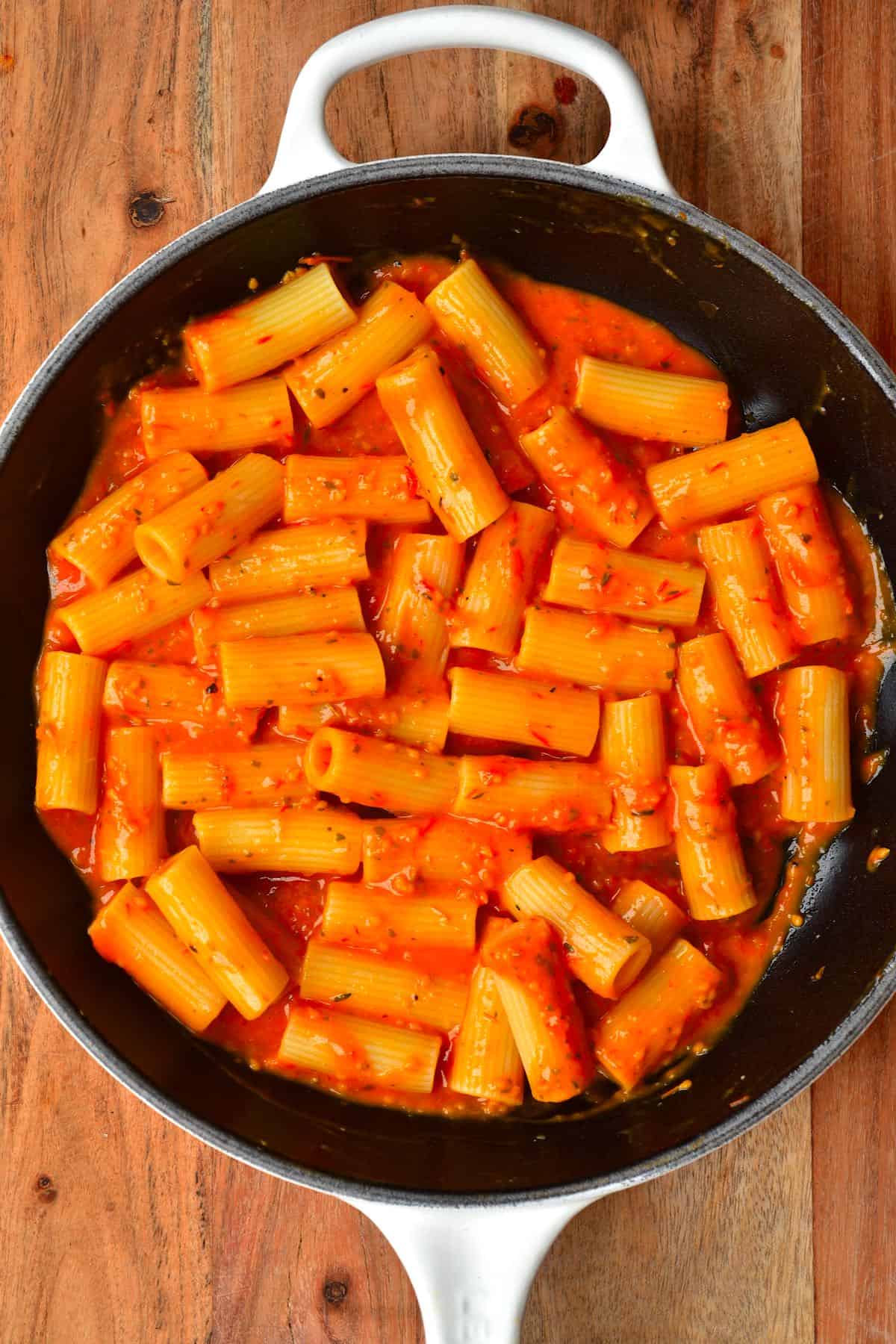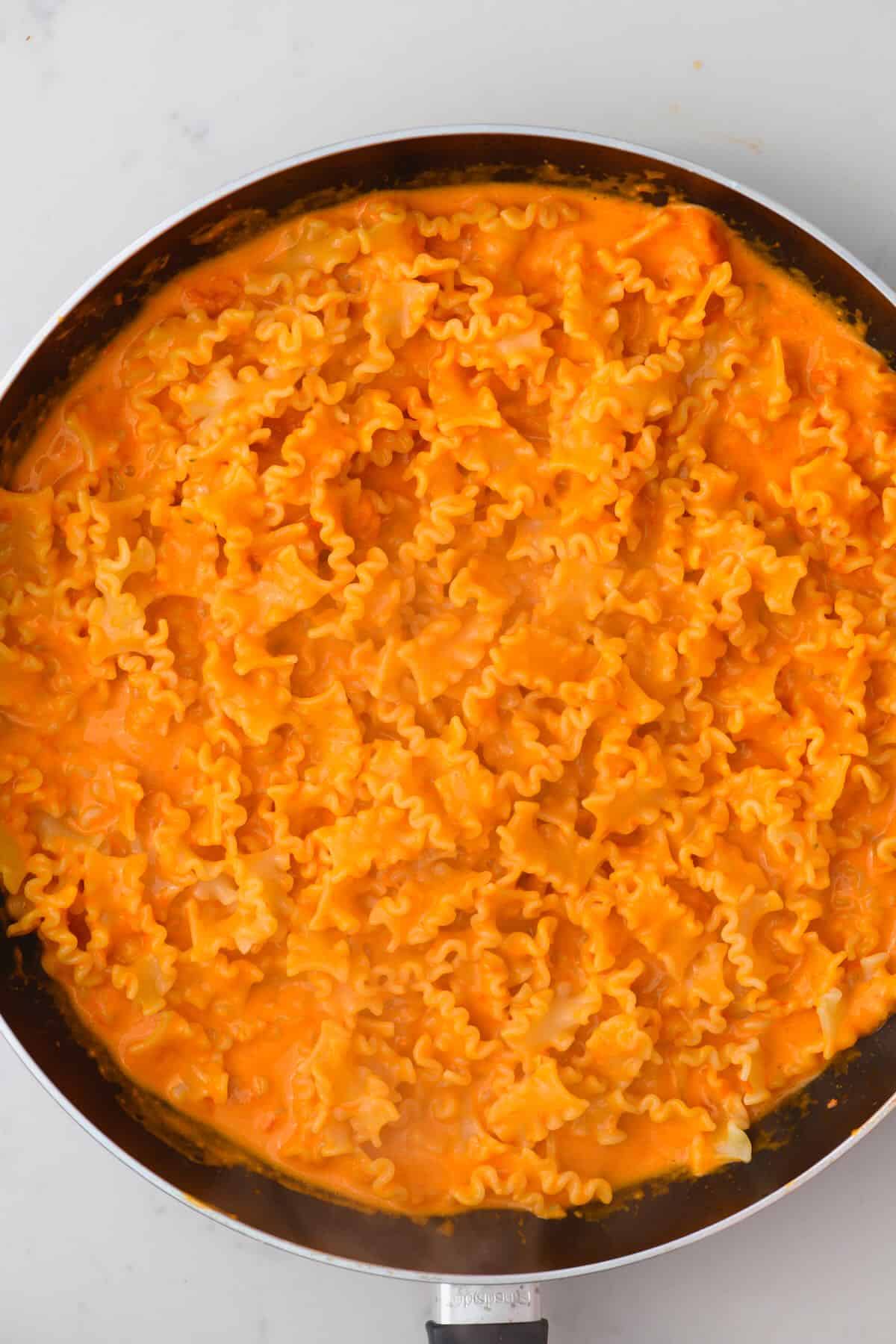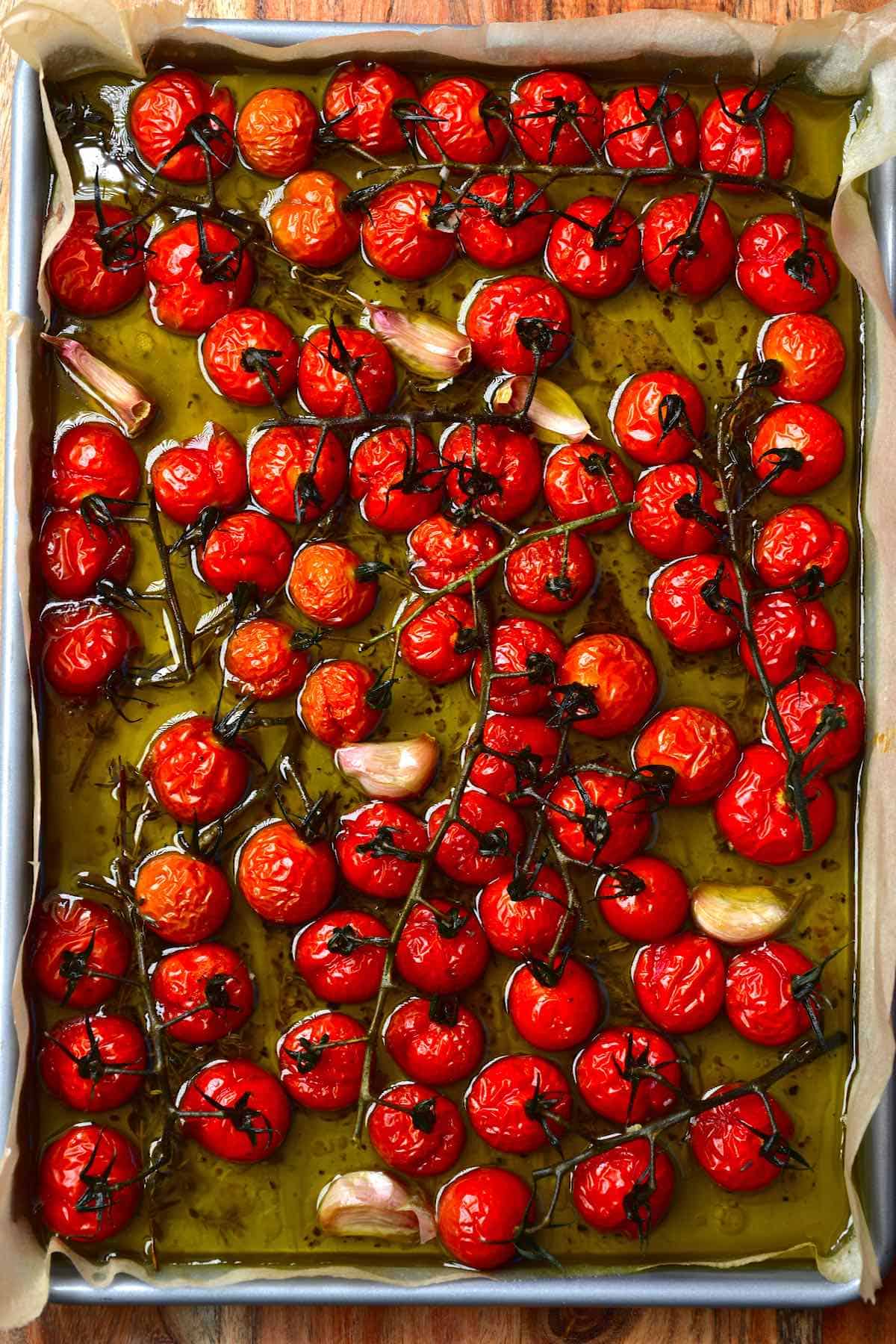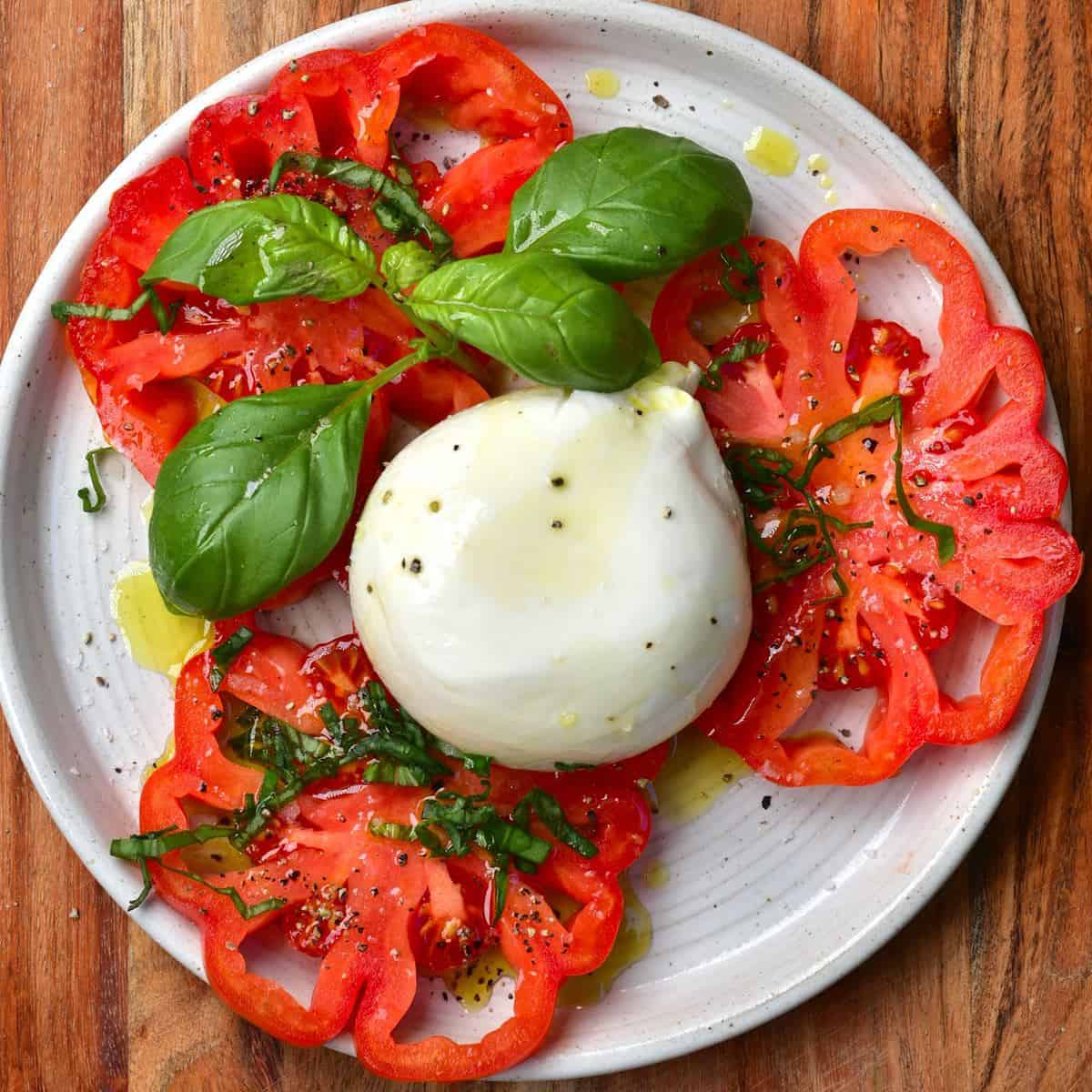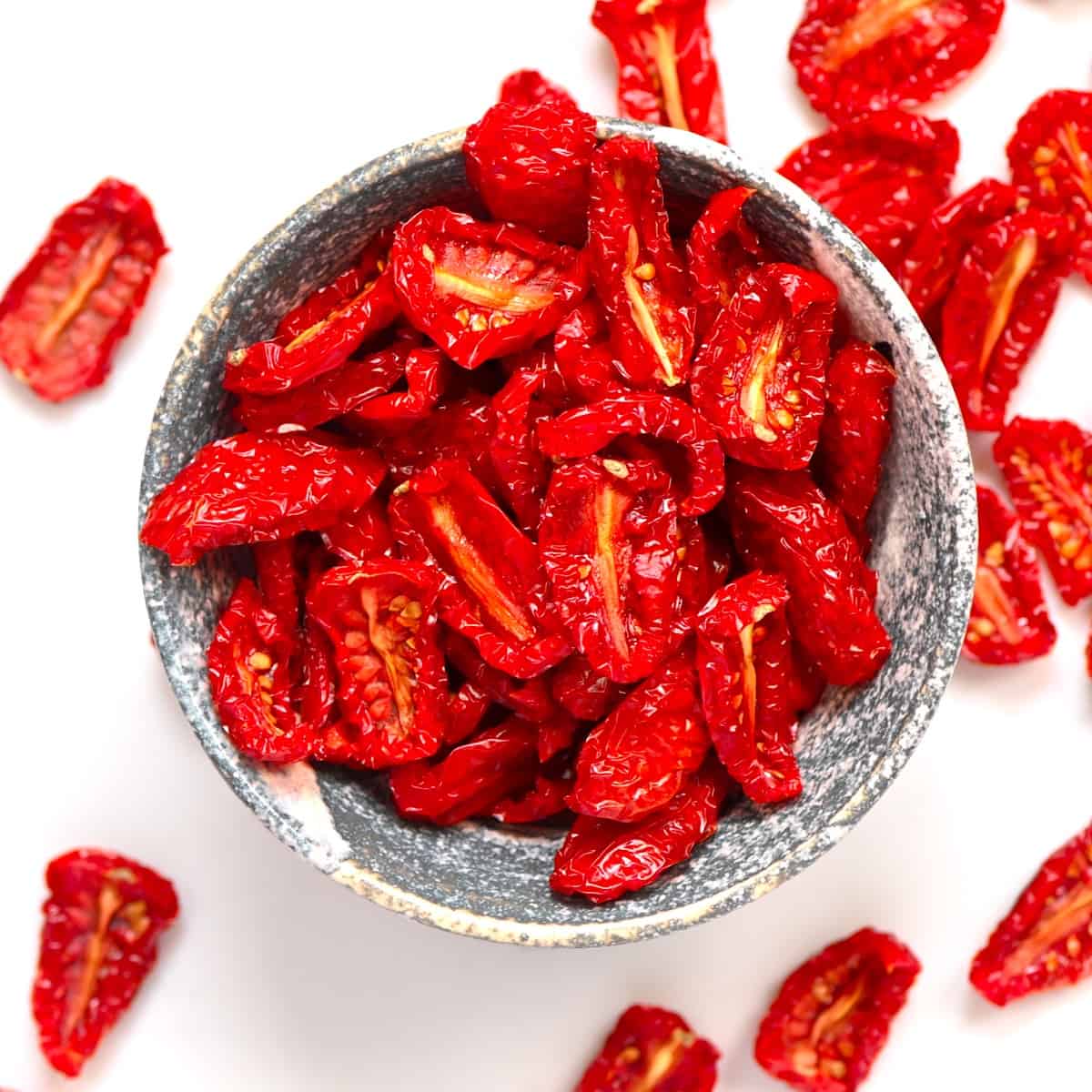This post may contain affiliate links. Please read our disclosure policy.
Enjoy homemade stovetop or roasted tomato sauce with fresh tomatoes (regular or cherry tomatoes) in as little as 20 minutes, with 5 ingredients, then freeze or can for later. This fresh tomato pasta sauce is rich, flavorful, versatile, and makes for a delicious and healthy sugar-free, dairy-free, vegan tomato sauce!
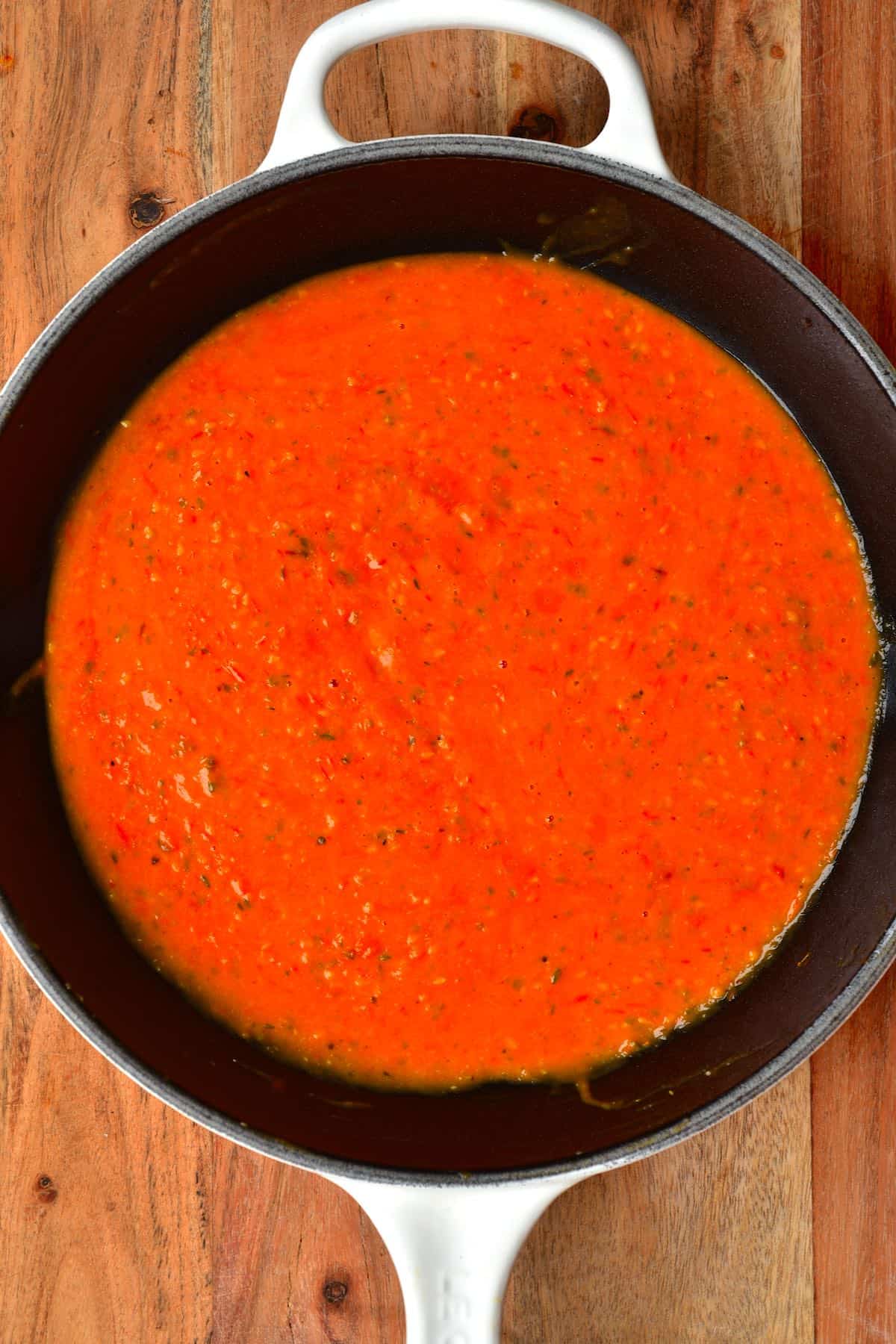
During tomato season I rush to make as many tomato-based dishes as possible while they’re at their ripest and juciest (like Caprese salad, Panzanella, tomato bruschetta, and Heirloom tomato salad). However, recipes like this stovetop/roasted tomato sauce from scratch are extra special. Because, you can make them during summer and freeze (or can) to enjoy for months to come!
I’ve really enjoyed sharing my recent pasta-making pursuits, like this Potato Gnocchi, Vegan Pasta, Oat pasta, and Homemade Ricotta And Spinach Ravioli (among several other pasta recipes). And, what does all fresh pasta need? A delicious homemade pasta sauce like this tomato sauce with fresh tomatoes.
In fact, I haven’t just included one method below for tomato sauce with fresh tomatoes, but two. The first is for a roasted cherry tomato sauce and the second – a stovetop quick tomato pasta sauce version. Having recently posted my method for homemade tomato confit, where I slow-roasted cherry tomatoes, the flavor was out of this world. While the roasted cherry tomato sauce definitely has less oil involved (phew), the flavor is still amazing. It’s well worth ditching jarred tomato sauce. However, it still takes a bit of time (30 minutes, or so). So, I’ve included a quicker stovetop version for those days you just don’t have the time!
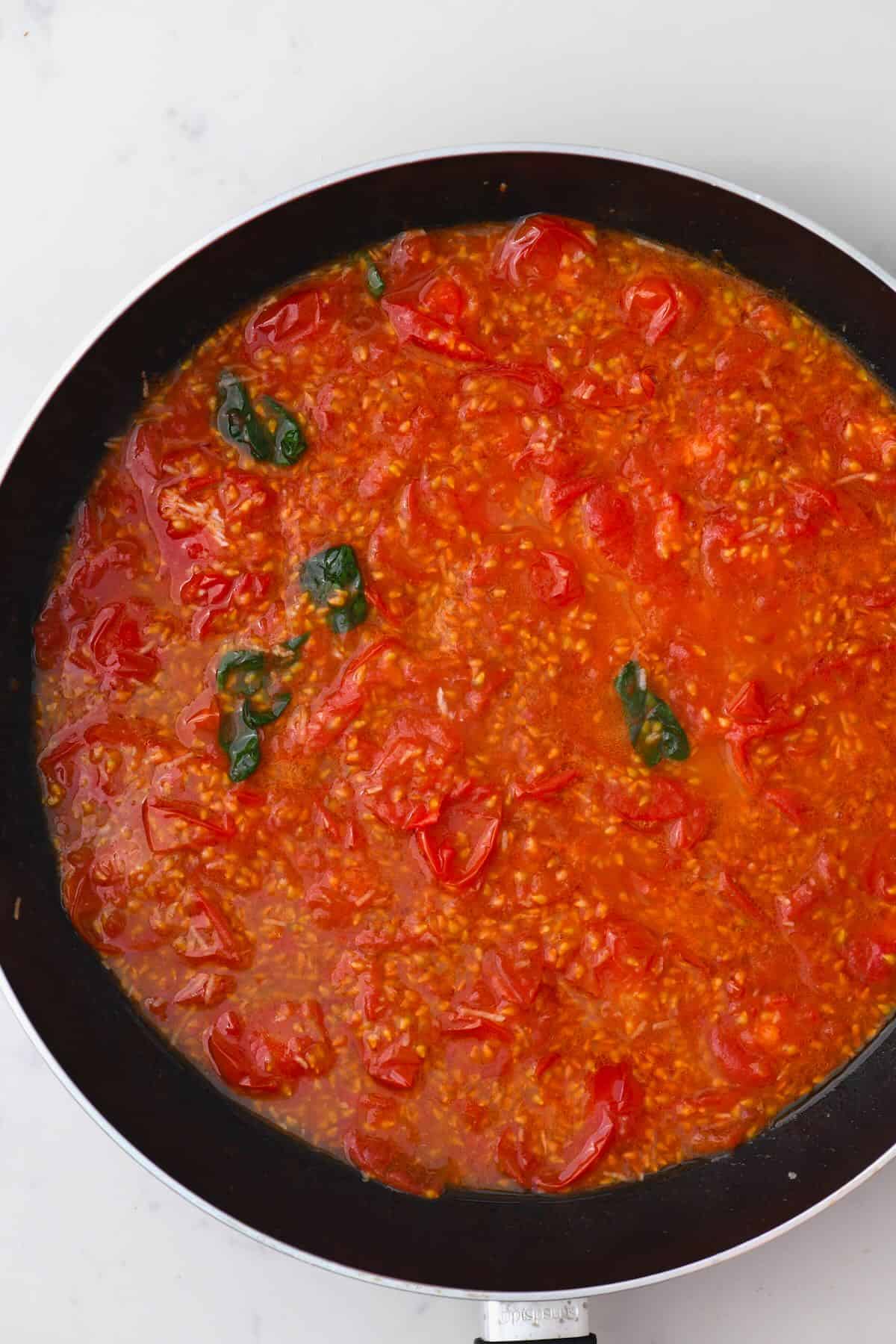
As much as I love my simple marinara sauce, the flavor you get from roasted tomato sauce is entirely different. The roasting process lightly caramelizes the tomatoes for a rich, sweet, multi-layered tomato flavor. When combined with some garlic, herbs, and salt & pepper – you have a healthy sugar-free tomato sauce that packs a ton of flavor and nutritional value!
When combined with just a handful of other ingredients like extra virgin olive oil, fresh herbs, garlic, and salt and pepper. That’s all you need for a fresh tomato pasta sauce you’ll return to time and time again!
The stovetop tomato basil pasta sauce isn’t quite as “developed” in flavor, but still tastes delicious when made with ripe and juicy tomatoes. I prefer to make it as pasta sauce with cherry tomatoes, which are flavorful, inexpensive, and easy to get your hands on.
Not only does this work as a healthy spaghetti sauce and pasta sauce, but this cherry tomato sauce can also be used in place of marinara over pizza too, with enchiladas, as a dip, and tons of other uses. Keep reading below for more serving recommendations!
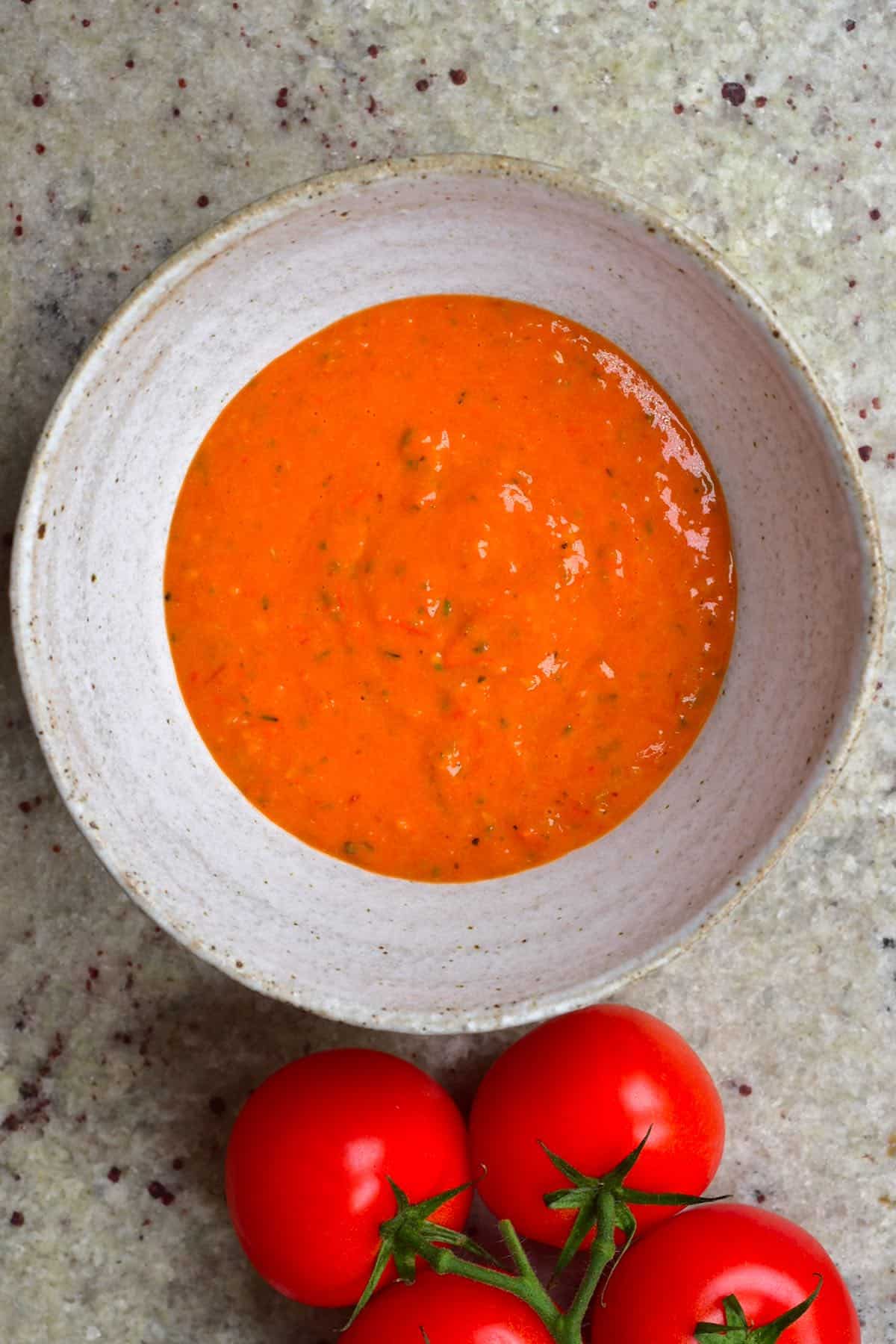
Want to save this recipe?
Table of Contents
- Marinara Vs. Tomato Sauce
- The Base Tomato Sauce Ingredients
- How To Make Roasted Tomato Sauce from Scratch?
- The Stovetop Quick Cherry Tomato Pasta Sauce Method
- How To Make Ahead & Store
- How to Serve
- FAQs
- Top Tips For The Best Tomato Sauce With Fresh Tomatoes
- Related Tomato Recipes & DIYs
- Homemade Stovetop or Roasted Tomato Sauce (Pasta Sauce) Recipe
Marinara Vs. Tomato Sauce
As I stated above, I’ve already posted a marinara sauce recipe to the blog previously. Marinara is quite often considered “the” tomato sauce – so what is the difference between marinara and tomato sauce?
Honestly, this depends on exactly what tomato sauce you’re making. Marinara sauce is known as a “quick sauce” and often uses tinned tomatoes and is seasoned and heated on the stovetop. In comparison, homemade tomato sauce often begins with pureed fresh tomatoes and can be made up of a simple or more complex combination of seasonings and sauce additions. The sauce is also generally simmered low and slow for a thick, rich flavor.
Marinara sauce Roasted tomato sauce – blended
The methods mentioned below seem to fall somewhere in the middle. While both make the homemade tomato sauce with fresh tomatoes, the roasted tomato sauce obviously roasts them in the oven, rather than simmering them on the stovetop.
The roasting adds complex flavors without the need for a long-simmering over the stove-top – which means a delicious sauce in a fraction of the time. However, you can also simmer and reduce the roasted tomatoes for sauce that is even thicker and more complex in flavor (both methods included below!).
In comparison, the stovetop quick tomato pasta sauce is my go-to my last-minute dinner plans. It doesn’t do a long simmer, so the flavor isn’t quite as rich as the other version, but it will get from kitchen to table in under 20 minutes!
The Base Tomato Sauce Ingredients
The ingredients for both versions (stovetop and roasted) are almost identical (and can be, if preferred).
- Tomatoes: I nearly always make this sauce with cherry tomatoes, which are inexpensive and avialable year-round (though best in season!). However, you can experiment with different tomatoes or even a combination of several types for different flavor profiles.
- Herbs: I use a combination of oregano and a bit of thyme when roasting and a few fresh basil leaves for the stovetop version. However, feel free to adjust this to your favorite flavors: rosemary, marjoram, Italian seasoning, bay leaf, etc.
- Garlic: added to the roasting pan for mellow, delicious flavor. Adjust the amount to taste
- Extra virgin olive oil: increases the health benefits of the tomatoes AND adds richness and flavor to the sauce.
- Salt & Pepper: to season, of course. And you can add chili flakes for a bit of heat (optional).
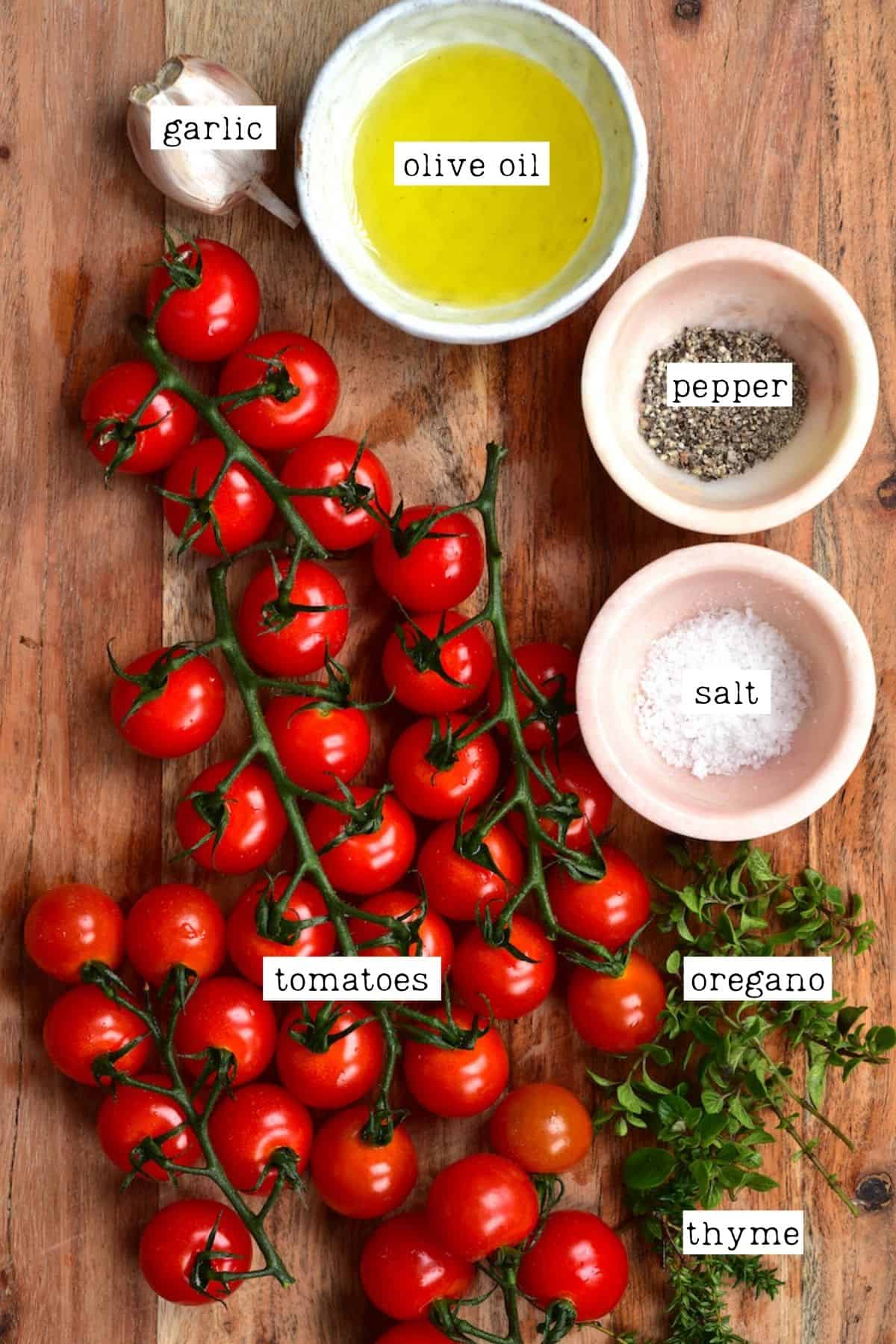
Optional Add-ins
One of the best things about this cherry tomato sauce is that it’s the perfect base for experimenting. There are tons of ways to jazz up the fresh tomato pasta sauce, from adding spice, creaminess, extra herbs and vegetables, etc. Here are some of my top options:
- Bay leaf: particularly when making the stovetop quick tomato pata sauce, add a bay leaf to the pan while simmering the tomatoes for extra flavor.
- Lemon: adding a tablespoon or so of lemon juice with some optional lemon zest adds extra body to this homemade spaghetti sauce with fresh tomatoes.
- Spicy roasted tomato sauce: for spice, you could also add chili/cayenne powder, chili flakes, or a little chili sauce.
- Creamy homemade tomato sauce: you can add a little butter, cream, or mascarpone. For a vegan version, you could use dairy-free butter and either canned coconut milk or another cream alternative like oat cream or cashew cream. You can also add dairy-free cream cheese.
- Cream cheese tomato pasta sauce: add cream cheese (plain or herby) to the sauce for a delicate creamy, cheesy flavor to the fresh tomato pasta sauce.
- Other Seasonings: onion powder, garlic powder, paprika or smoked paprika, etc.
- Sugar: this is naturally a sugar-free tomato sauce. However, you might be surprised to learn that a spoonful of sugar can create even more depth to the tomato sauce flavors as it cuts through the acidity. A sugar-free sweetener should also work.
- Tomato puree/paste: you don’t need much, but the pure, concentrated flavor can add depth to the sauce.
- Vegetables: you can add finely chopped and sauteed vegetables like onion, mushrooms, celery, leek, carrot, etc. Alternatively, ingredients like olives add a little acidity and extra savory flavor to any fresh tomato sauce.
- Red wine/white wine: a great addition if you plan to simmer/reduce the cherry tomato sauce. It adds flavor and richness to the sauce without becoming ‘boozy.’
How To Make Roasted Tomato Sauce from Scratch?
Making tomato sauce from scratch needn’t be difficult. In fact, this entire process is made up of just 3 steps (and an optional 4th): prepare, roast, blend, reduce!
Step 1: Prepare the Ingredients
First, clean the tomatoes. If using large tomatoes, you can cut them in half. Then add the herbs to the bottom of a large baking dish. Place the tomatoes on top of them (this will help them not burn) together with the garlic, salt, pepper, and olive oil.
Feel free to remove the tomato stalks or leave them on for now. The same goes for the garlic – you can leave it with the peel on or peeled, whole or minced.
Step 2: Roast the Cherry Tomatoes
Roast the tomatoes in the oven at 400ºF/200ºC for about 20 minutes. The tomatoes will begin to shrivel up and burst.
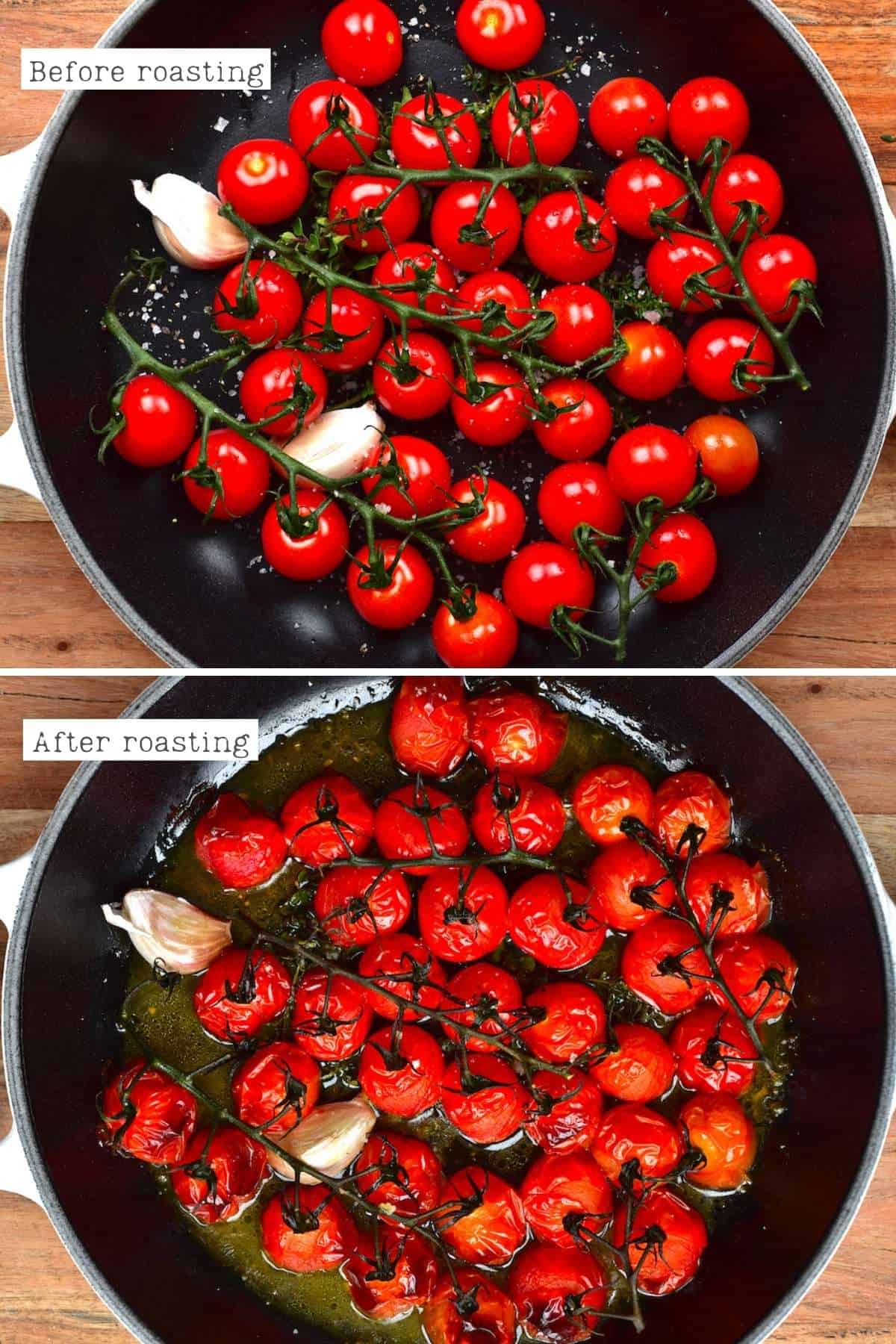
If you keep them attached to the stalks, they tend to hold their shape better while cooking. However, as soon as the stalks are removed, the tomatoes will “fall apart”. This is completely normal as they are super tender and soft.
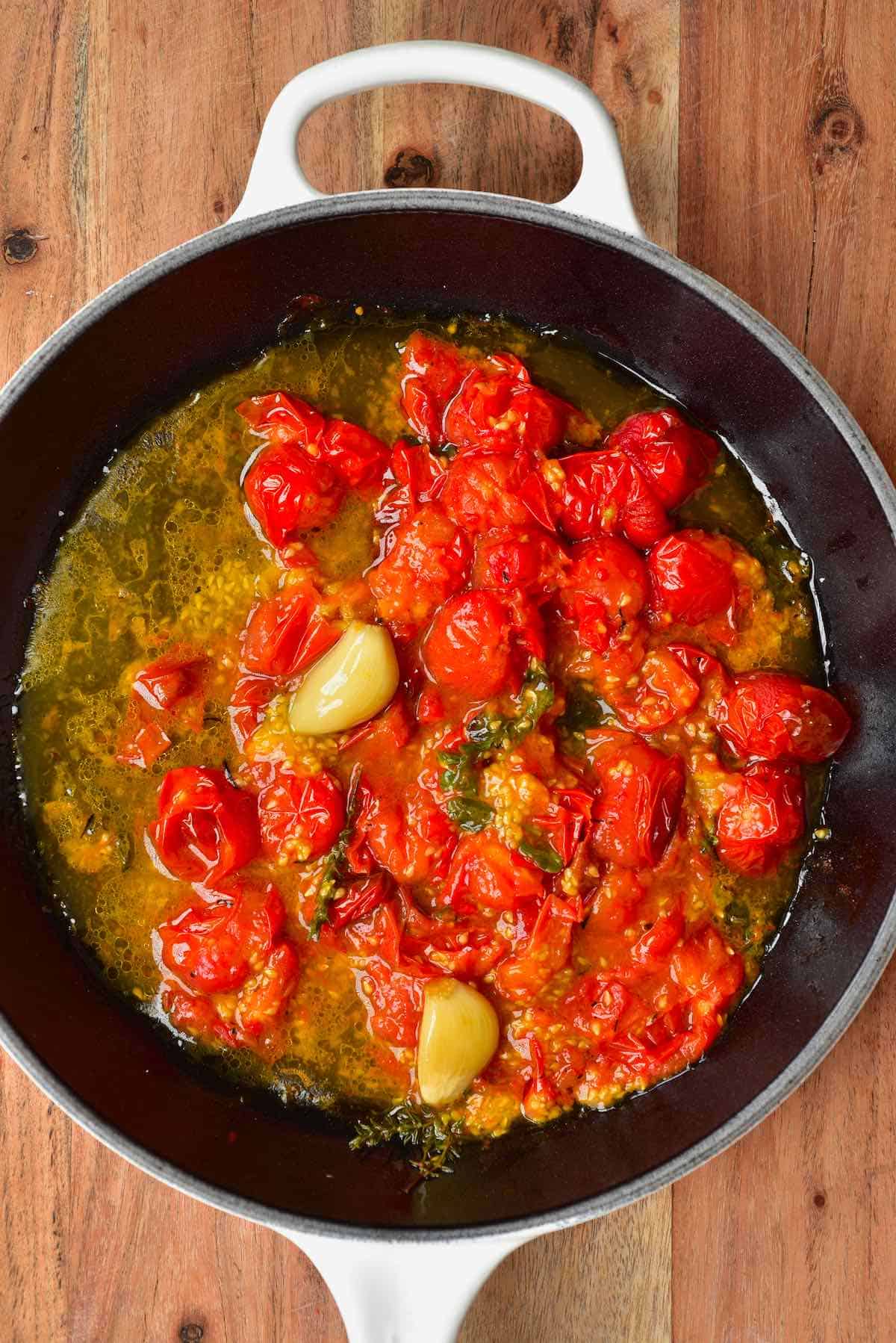
Step 3: Blend the Roasted Cherry Tomato Sauce
Allow the roasted tomatoes to cool for a few minutes (until you’re able to handle them). Then remove the tomato stalks and garlic skin. Then add everything from the pan (herbs, juices, and all) to a food processor. Blend into a smooth tomato sauce.
You may also be able to mash them by hand for a chunkier sauce – with or without the skins.
Taste the fresh tomato sauce and adjust any seasonings to taste. At this point, you can use the sauce as is, jar it for later use, or simmer it on the stovetop to reduce.
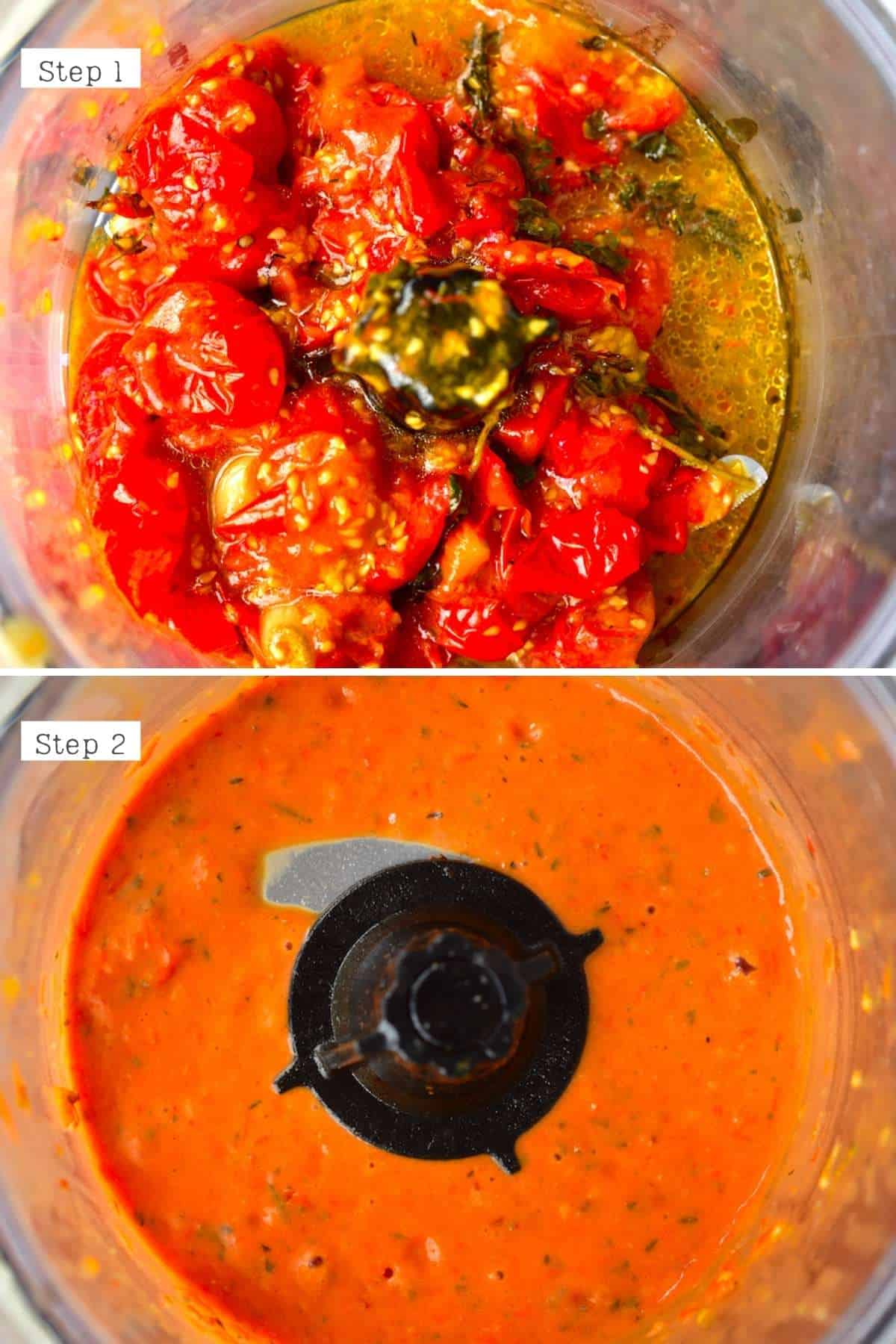
(Optional) Step 4: How to Thicken Tomato Sauce
Pour the homemade tomato sauce in a large saucepan. Then, reduce over medium-low heat for 15 minutes (up to 30 minutes). This will reduce and thicken the sauce and concentrate the flavors.
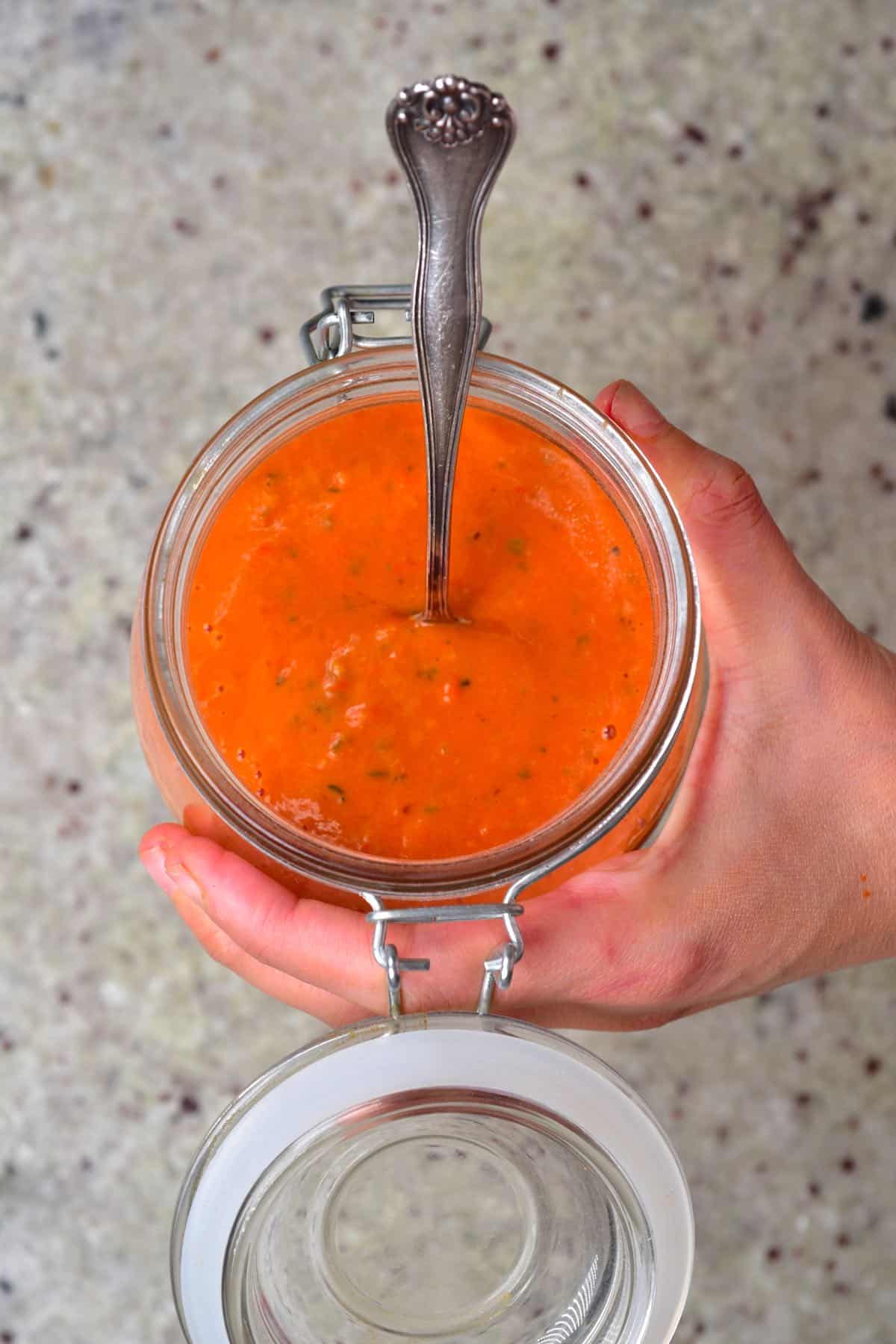
The Stovetop Quick Cherry Tomato Pasta Sauce Method
This simple tomato basil pasta sauce make on the stovetop requires just a few simple steps.
First, mince or grate the garlic and chop the tomatoes in half (if using cherry tomatoes, quarters for larger tomatoes).
Then, heat the oil in a large skillet over medium heat and add the tomatoes. Cook for several minutes (3-4), stirring occasionally until the tomatoes are beginning to soften. Then cover the pan with a lid and reduce the heat to low.
Continue to cook for several minutes until the tomatoes have burst and are very tender. Then remove the lid and add the garlic and a few basil leaves. Allow it to cook and infuse for a few more minutes.
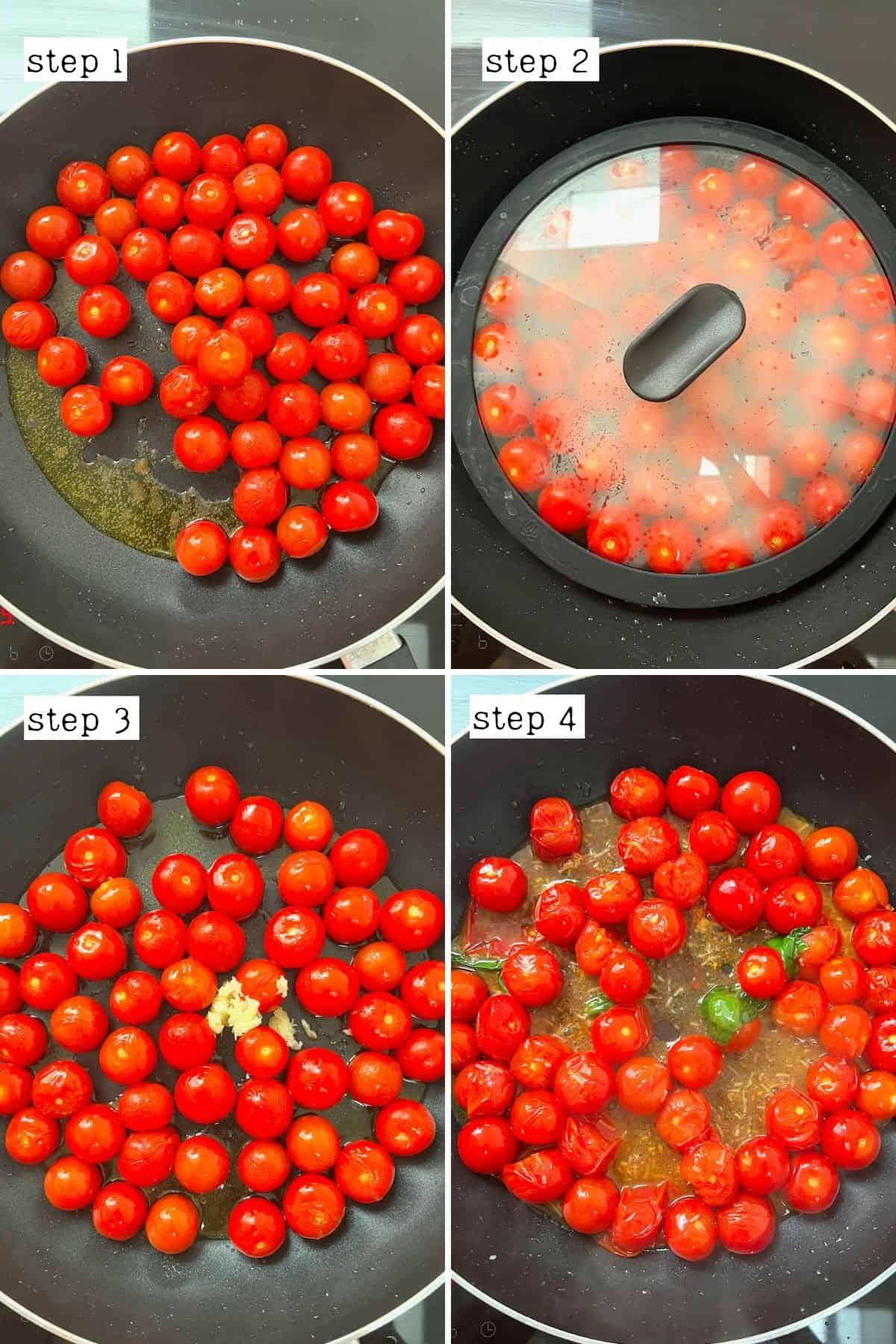
Next, use either a fork or potato masher to gently mash the tomatoes in the pan. Alternatively, you can use a blender, to blend them until completely smooth.
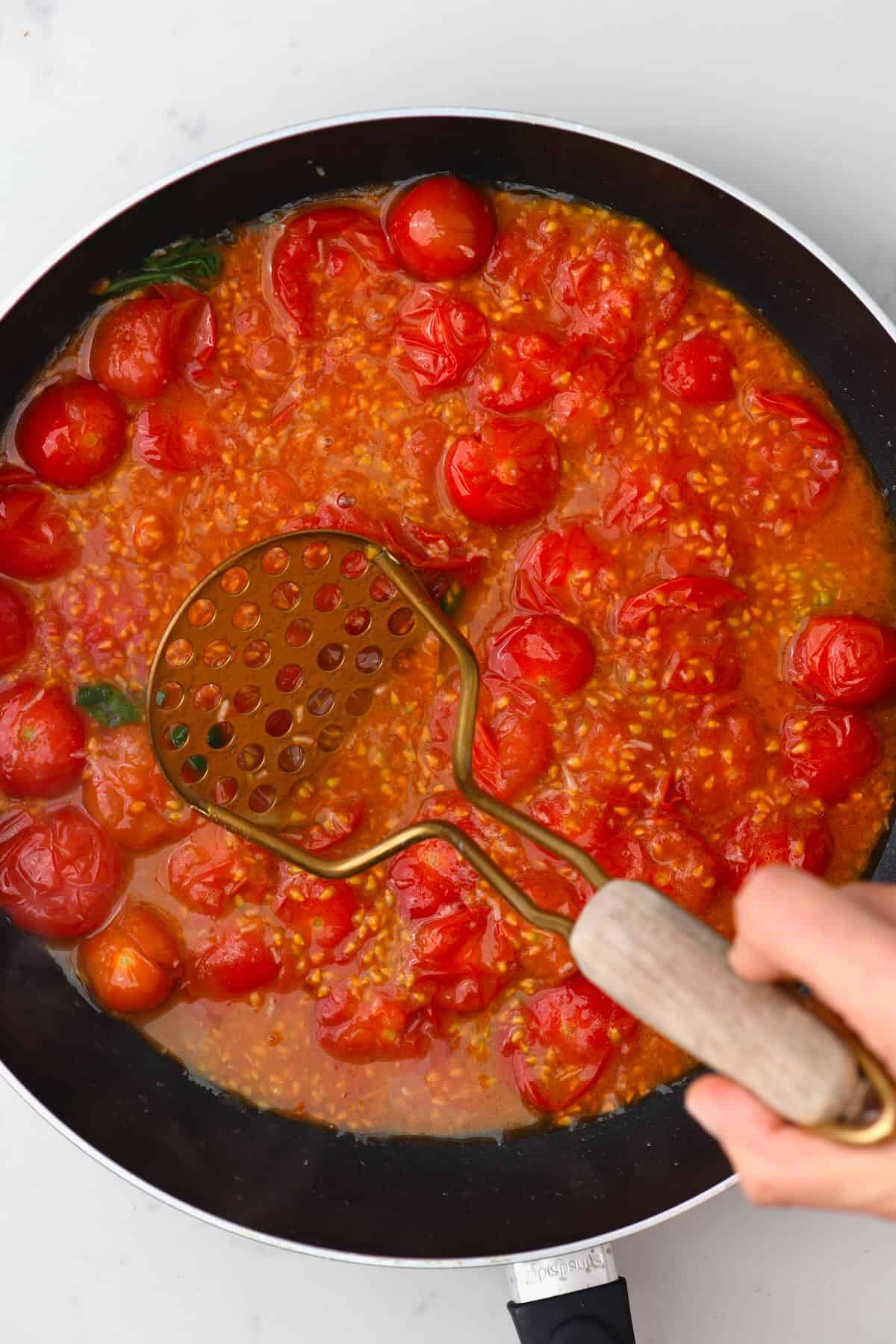
You can optionally remove the tomato peels. However, I usually don’t as I blend the sauce and they aren’t noticeable at all. If the sauce is too thin, return it to the skillet and heat over medium-low until slightly thickened and reduced.
Before using the tomato garlic pasta sauce, optionally add a ladle-full or so of pasta water to the sauce and mix well. Then use and enjoy!
How To Make Ahead & Store
Store: keep any leftover homemade tomato sauce (of either version) in a sterilized jar/container in the fridge for up to 7 days.
Freeze: it’s very easy to freeze tomato sauce. Allow the fresh tomato pasta sauce to cool. Then transfer to Ziplock bags (in portions is best), flattening and squeezing out any excess air. Then freeze for up to 3 months. Allow it to thaw in the fridge or on the counter. Alternatively, place the bag in a bowl/container of hot water or under running hor water, to give it a headstart.
For advice on canning the cherry tomato sauce, refer to the FAQs below!
To reheat: you can reheat the fresh tomato pasta sauce from frozen or chilled in a microwave or on the stovetop. Add an extra splash of liquid (water/broth/milk) if necessary.
Pasta in oven-roasted tomato sauce Pasta in stovetop cooked tomato sauce
How to Serve
There are several ways that you can enjoy this roasted tomato sauce with cherry tomatoes, including:
- For pasta dishes: enjoy this roasted tomato pasta sauce with all kinds of pasta dishes – like this roasted tomato pasta, Vegetarian One-Pot Pasta bake, or with gnocchi or ravioli, etc.
- As a dip: for quesadillas and finger foods, like this Puff Pastry Spinach Ricotta Pie ‘Tarte Soleil’ – in this case, you might want to reduce the sauce so it has a thicker consistency.
- As a sauce: for dishes like homemade enchiladas, or eggs – like this Healthy Easy Shakshuka.
- Spooned over proteins: like homemade tofu, tempeh, Paneer, fish, or chicken.
- As a pizza sauce: for traditional pizza or even “quick” cheat pizzas using a homemade pita or naan bread base.
Let me know in the comments what your favorite way of using this stovetop or roasted tomato sauce with fresh tomatoes is!
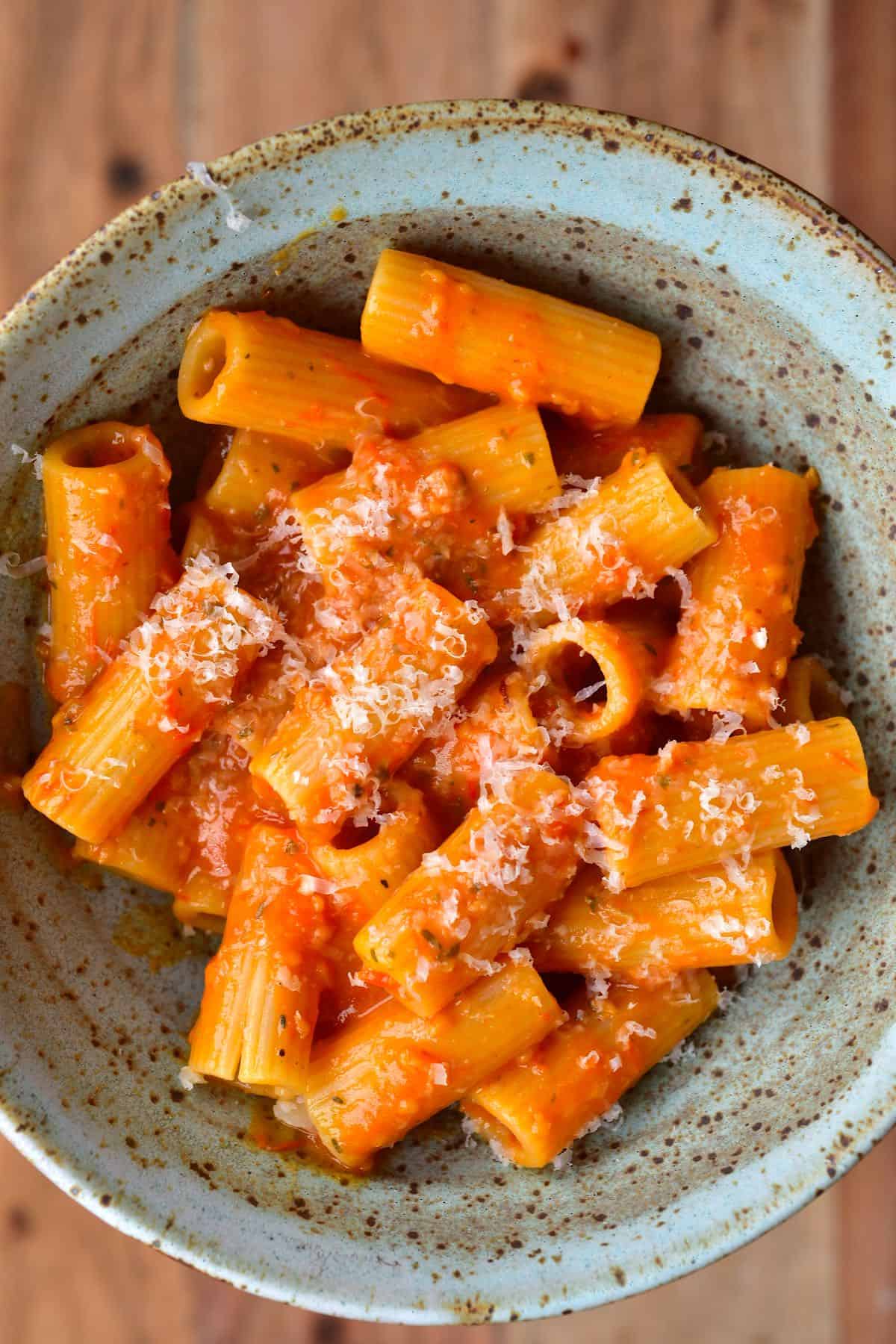
FAQs
Roasting tomatoes (and most veggies) will help to caramelize the natural sugars in the ingredients and cook away some of the liquid content, leading to more concentrates, intense, sweeter flavor bombs. In tomatoes, it seems to be particularly noticeable, though, with many people ONLY enjoying either raw or roasted tomatoes because of the flavor difference.
You should be able to, though I have yet to try. You can refer to this USDA-approved guide for canning tomato products regarding the processing times and my post on water bath canning for the method and all my top tips!
This is entirely up to you. When blending the ingredients, they are barely noticeable. However, if you do have a textural issue with them, then feel free to pick them out of the pot (this should be easy to do once the tomatoes are cooked).
In terms of overall quality and flavor, San Marzano and Roma tomatoes are known for their superior quality. However, when it comes to making any tomato sauce with fresh tomatoes, it’s best to just use the ripest, most flavorful tomatoes available to you and try to avoid using tomatoes that are overly seedy/watery. I love using cherry tomatoes as I find them concentrated in sweet and robust flavor, perfect for making a delicious cherry tomato pasta sauce!
Tomatoes contain high levels of water, so it’s no surprise that making homemade tomato sauce with fresh tomatoes can run the risk of a watery tomato pasta sauce unless the excess liquid is adequately dealt with (read the below Q) or less seedy tomatoes are chosen.
My favorite way to reduce the fresh tomato pasta sauce is by gently simmering it over low heat, stirring regularly (to avoid scorching). This won’t alter the flavor but can take up to 20-25 minutes (or as little as 8-10 minutes).
If you’re in more of a rush, you could use a cornstarch slurry to add to the sauce. I recommend using 1 tablespoon of cornstarch dissolved in a bit of water to begin. Add another tablespoon if necessary.
Surprisingly, adding pasta water to the sauce can also help it, thanks to the starches in the water. Even better if you cook the pasta in less water than usual, so the starch is extra concentrated.
Technically, yes. Though the canned tomato pasta sauce recipe will then be very similar to my marinara recipe and the flavor/texture will vary.
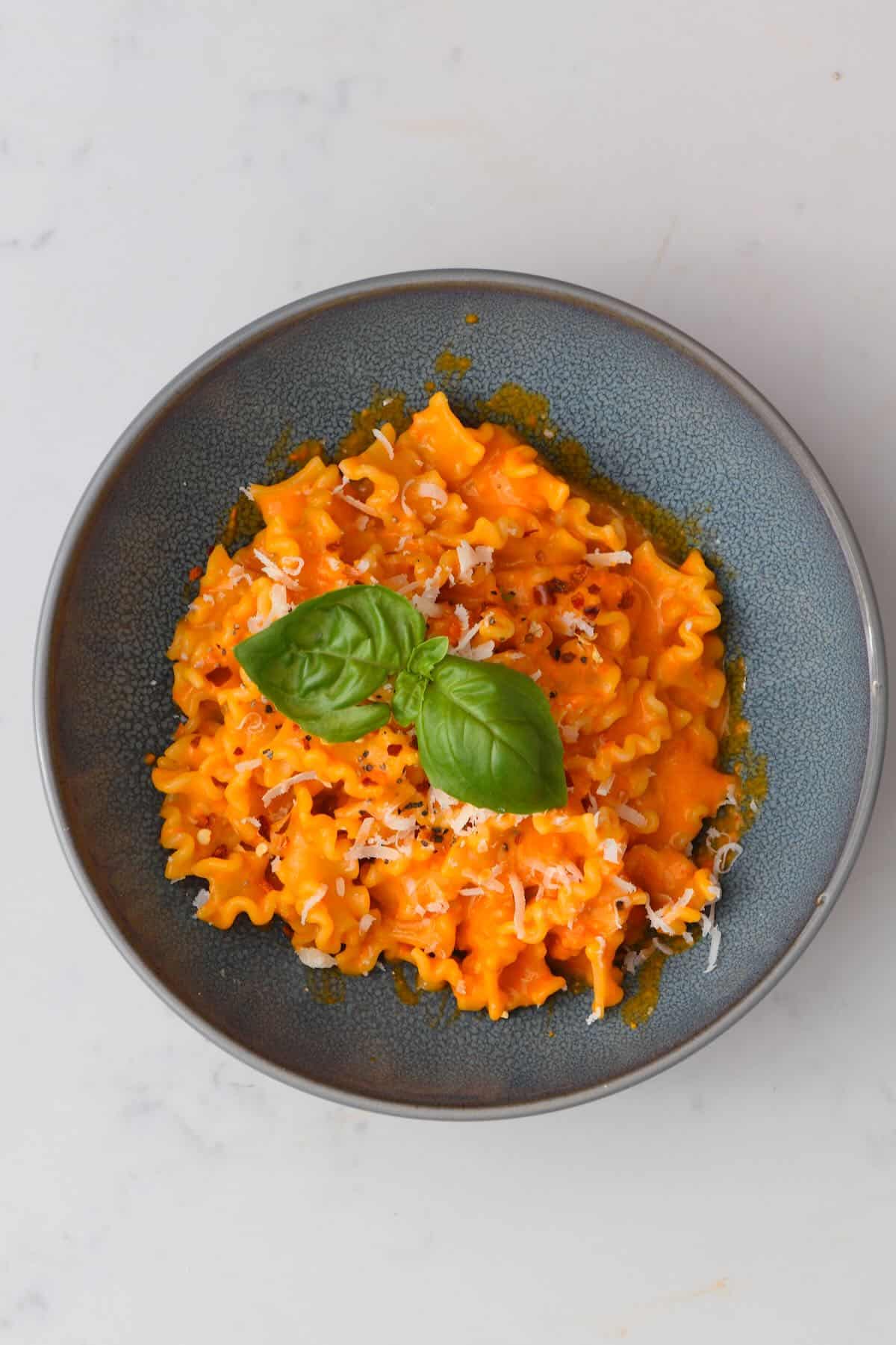
Top Tips For The Best Tomato Sauce With Fresh Tomatoes
- Use fresh, ripe tomatoes: that aren’t too green or firm. The more flavorful the tomatoes, the better the tomato sauce!
- This recipe makes for a perfect “base” homemade pasta sauce: while it tastes DELISH on its own, there are tons of ways to experiment with even more flavors and add-ins. Check out the Ingredients Section above for tons of ideas on how to take this sauce further! (It’ll be a great healthy spaghetti sauce!)
- Two ways to enjoy this fresh tomato sauce: enjoy this sauce in under 30 minutes by roasting and blending. Alternatively, gently simmer the tomatoes on the stovetop for a “quick” tomato basil pasta sauce.
- To adjust the consistency: if you find the sauce a little too “thin”, then return it to a skillet and heat over medium-low until thickened and reduces to your desired level.
Related Tomato Recipes & DIYs
- How To Make Tomato Confit (Slow-Roasted Tomatoes)
- Heirloom Burrata Caprese Salad (Burrata Salad)
- How to Make “Sun-Dried” Tomatoes (In Oven or Dehydrator)
- Easy Homemade Creamy Tomato Soup
- How to Make Tomato Purée/ Paste
- How To Make Pico De Gallo (Salsa Fresca)
- Simple Roasted Red Pepper Sauce
- Easy Gazpacho Recipe (Cold Tomato Soup)
- Vegetarian Minestrone Soup (Vegetable Tomato Pasta Soup | 3 Methods)
- Vegetarian Greek Stuffed Tomatoes (GF + Vegan Optional)
If you try this recipe for easy stovetop or roasted tomato sauce with cherry tomatoes, then let me know your thoughts and questions in the comments. I’d also really appreciate a recipe rating and would love to see your recreations – just tag @AlphaFoodie.
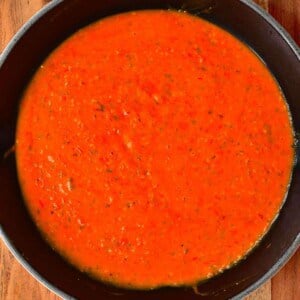
Homemade Stovetop or Roasted Tomato Sauce (Pasta Sauce)
Equipment
Ingredients
These ingredients yield about 1.25 cups of roasted tomato sauce
- 1 lb cherry tomatoes or any other variety
- few sprigs fresh herbs oregano or thyme (or both); basil for stovetop method is great
- 2 Tbsp olive oil
- 2 garlic cloves
- 1/2 tsp salt
- 1/4 tsp pepper
Check the blog post for tons of optional add-in ingredients, including seasonings, spice, etc.
Instructions
The Oven Roasting Method
Step 1: Prepare the Ingredients
- Clean the tomatoes. If using large tomatoes, you can cut them in half.
- Add the herbs to the bottom of a large baking dish and place the tomatoes on top of them (this will help them not burn) together with the garlic, salt, pepper, and olive oil.Feel free to remove the tomato stalks or leave them on for now. The same goes for the garlic – you can leave it with the peel on or peeled, whole or minced.
Step 2: Roast the Tomatoes
- Roast the tomatoes in the oven at 400ºF/200ºC for about 20 minutes. The tomatoes will begin to shrivel up and burst.If you keep them attached to the stalks, they tend to hold their shape better while cooking. However, as soon as the stalks are removed, the tomatoes will "fall apart" – this is completely normal as they are super tender and soft.
Step 3: Blend the Roasted Tomato Sauce
- Allow the roasted tomatoes to cool for a few minutes (until you're able to handle them) and then remove the tomato stalks and garlic skin. Then add everything from the pan (herbs, juices, and all) to a food processor and blend into a smooth tomato sauce consistency.You may also be able to mash them by hand for a chunkier sauce – with or without the skins.
- Taste the fresh tomato sauce and adjust any seasonings to taste. At this point, you can use the sauce as is, jar it for later use, or go one step further and simmer it on the stovetop.
(Optional) Step 4: How to Thicken Tomato Sauce
- Pour the homemade tomato sauce in a large saucepan and reduce over medium heat for at least 15 minutes (up to 30 minutes even). This will reduce and thicken the sauce and concentrate the flavors.
The Stovetop Method
- Mince or grate the garlic and chop the tomatoes in half (if using cherry tomatoes, quarters for larger tomatoes).
- Heat the oil in a large skillet over medium heat and add the tomatoes. Cook for several minutes (3-4), stirring occasionally until the tomatoes are beginning to soften. Then cover the pan with a lid and reduce the heat to low. Continue to cook for several minutes until the tomatoes have burst and are very tender. Then remove the lid and add the garlic and a few basil leaves and allow to cook and infuse for a few more minutes.
- Use either a fork or potato masher to gently mash the tomatoes in the pan. Alternatively, you can use a blender, to blend them until completely smooth. You can optionally remove the tomato peels. However, I usually don't as I blend the sauce and they aren't noticeable at all. If the sauce is too thin, return it to the skillet and heat over medium-low until slightly thickened and reduced to your desired consistency.Before using the tomato sauce, optioanlly add a ladle-full or so of pasta water to the sauce and mix well. Then use and enjoy!
How To Store
- Store: keep any leftover homemade tomato sauce (of either version) in a sterilized jar/container in the fridge for up to 7 days.Freeze: it's very easy to freeze tomato sauce. Allow the fresh tomato pasta sauce to cool and then transfer to Ziplock bags (in portions is best), flattening and squeezing out any excess air. Then freeze for up to 3 months. Allow it to thaw in the fridge or on the counter. Alternatively, place the bag in a bowl/container of hot water or under running hor water, to give it a headstart. For advice on canning the cherry tomato sauce, refer to the FAQs in the blog post!To reheat: you can reheat the fresh tomato pasta sauce from frozen or chilled either in a microwave or on the stovetop. Add an extra splash of liquid (water/broth/milk) if necessary.
Video
Notes
- Use fresh, ripe tomatoes that aren’t too green or firm. The more flavorful the tomatoes, the better the tomato sauce!
- This recipe makes for a perfect “base” homemade pasta sauce. While it tastes DELISH on its own, there are tons of ways to experiment with even more flavors and add-ins. Check out the Ingredients Section on the blog post for tons of ideas on how to take this sauce further! (It’ll be a great healthy spaghetti sauce!)
- There are two ways to enjoy this roasted tomato sauce: enjoy this sauce in under 30 minutes by roasting and blending. Alternatively, feel free to simmer and reduce the sauce further for thicker, richer results.
- You can, optionally, remove the tomato skins. I don’t find it necessary since they blend up well and don’t create any bad textures. However, if you prefer to remove them, wait until they’re cool enough to handle (post-roast). They should peel easily.
Nutrition
Nutrition information is automatically calculated, so should only be used as an approximation.

